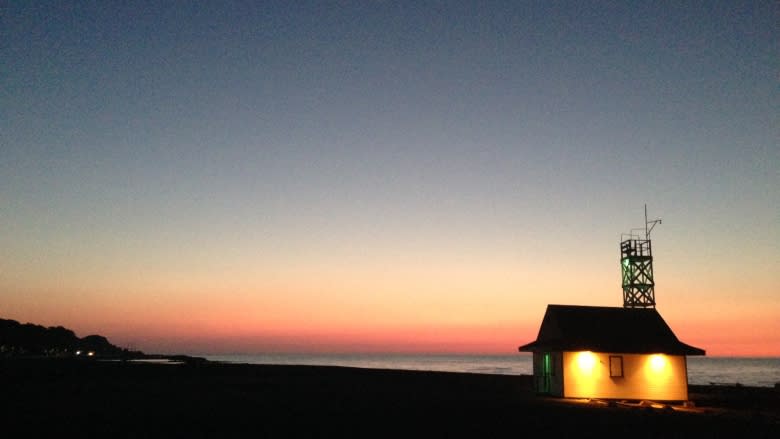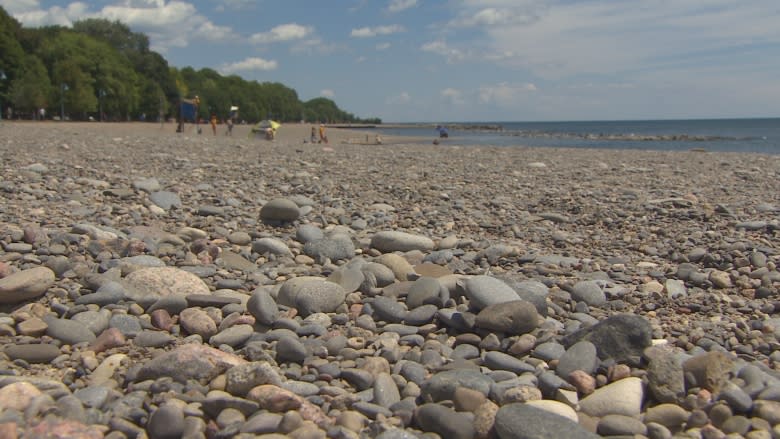Rising water line in The Beach 'normal' - but all is not well on Toronto's shore
An image of the lake creeping up towards the boardwalk near Wineva Avenue has some residents in The Beach concerned about erosion at one of the city's favourite destinations.
But Nancy Gaffney, waterfront specialist with the Toronto and Region Conservation Authority (TRCA), told CBC Toronto the sand that's currently underwater on the beaches south of Queen Street East and Woodbine Avenue will be back.
"It looks like the waves are pulling a lot of material out. It won't hurt the sand beach in the long-term," she said. "The sand will get replaced over time."
The city will only move in with a "temporary fix," Gaffney said, if the nearby infrastructure in the popular east-end neighbourhood becomes threatened.
"It's when it starts pulling out pieces of your boardwalk that it starts to become a problem."
The higher water level, she said, "is just the regular up-and-down of the lake. It was much, much higher in the 80s. They do expect that it's going to stay quite high for the remainder of 2017."
The lake-water level is governed by yearly and multi-year cycles, said Gaffney, meaning it fluctuates year-to-year as well as regularly rising in the spring and summer.
University of Toronto geography professor Harvey Shear agrees that a high water level is a normal occurrence, though he added that he was a "bit surprised" that the lake levels were up since Lake Ontario is regulated by the Moses-Saunders Power Dam — and has been since the St. Lawrence Seaway was completed in 1959.
Shear chalks up the current high water level to a possible change to water regulation at the dam. He say it could also be the result of the region's "relatively mild winter, with more rain and less snow."
Concern over erosion in some areas
Though the high-water level doesn't set off alarm bells for Gaffney, she said there are concerns about the health of parts of Toronto's beaches and the islands.
"There are some critical areas that have lost much of the beach" due to erosion, she said, which becomes an issue when nearby infrastructure is threatened.
The area around the iconic Leuty lifeguard station on Kew Beach, for example, has "suffered a lot of erosion," she said. "We're working with the city to address some of those issues."
In the last five to 10 years, climate change has brought stronger winds, storms and waves to the lake, Gaffney said, requiring a "comprehensive solution to the long term changes to Lake Ontario in general," including a possibility of more aggressive shoreline protection.
One technique being used on parts of the Toronto shoreline involves converting sand beaches to "cobble" or "shingle" beaches, covering the beach with small stones.
But Gaffney said that's not likely for the eastern beaches. "We are interested in keeping the sand beach," she explained.
Some beaches — such as Balmy Beach — also get rockier after yearly dredging of the lake.
The TRCA is also taking aggressive action this year on the Toronto Islands to protect Gibraltar point, where serious erosion is putting infrastructure in jeopardy.
So what will happen to Toronto's beaches as climate change intensifies in the future?
Shear doesn't believe beach-goers have anything to worry about.
Thanks to warmer temperatures and increased evaporation, "Lake Ontario is projected to drop by the end of the century by about a foot-and-a-half," he said.
That's not great news for wetlands wildlife, said Shear, but if you like sand beaches, you're in luck.



